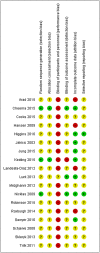High intensity training in obesity: a Meta-analysis
- PMID: 29071102
- PMCID: PMC5598019
- DOI: 10.1002/osp4.109
High intensity training in obesity: a Meta-analysis
Abstract
Introduction: High Intensity training (HIT) is a time-effective alternative to traditional exercise programs in adults with obesity, but the superiority in terms of improving cardiopulmonary fitness and weight loss has not been demonstrated.
Objective: to determine the effectiveness of HIT on cardiopulmonary fitness and body composition in adults with obesity compared to traditional (high volume continuous) exercise.
Methods: A systematic search of the main health science databases was conducted for randomized controlled trials comparing HIT with traditional forms of exercise in people with obesity. Eighteen studies were included in the meta-analysis. The (unstandardized) mean difference of each outcome parameters was calculated and pooled with the random effects model.
Results: HIT resulted in greater improvement of cardiopulmonary fitness (VO2max) (MD 1.83, 95% CI 0.70, 2.96, p<0.005; I2=31%) and a greater reduction of %body fat (MD -1.69, 95% CI -3.10, -0.27, p=0.02, I2=30%) compared to traditional exercise. Overall effect for BMI was not different between HIT and traditional exercise.
Conclusion: Training at high intensity is superior to improve cardiopulmonary fitness and to reduce %body fat in adults with obesity compared to traditional exercise. Future studies are needed to design specific HIT programs for the obese with regard to optimal effect and long-term adherence.
Keywords: Exercise; High intensity training; Obesity.
Figures






References
-
- Global Recommendations on Physical Activity for Health . WHO Guidelines Approved by the Guidelines Review Committee. Geneva 2010.
-
- Allender S, Foster C, Boxer A. Occupational and nonoccupational physical activity and the social determinants of physical activity: results from the Health Survey for England. J. Phys. Act. Health 2008; 5: 104–116. - PubMed
-
- Sherwood NE, Jeffery RW. The behavioral determinants of exercise: implications for physical activity interventions. Annu. Rev. Nutr. 2000; 20: 21–44. - PubMed
-
- Lidegaard LP, Schwennesen N, Willaing I, Faerch K. Barriers to and motivators for physical activity among people with Type 2 diabetes: patients' perspectives. Diabet. Med. 2016; 33: 1677–1685. - PubMed
Publication types
LinkOut - more resources
Full Text Sources
Other Literature Sources
Medical
